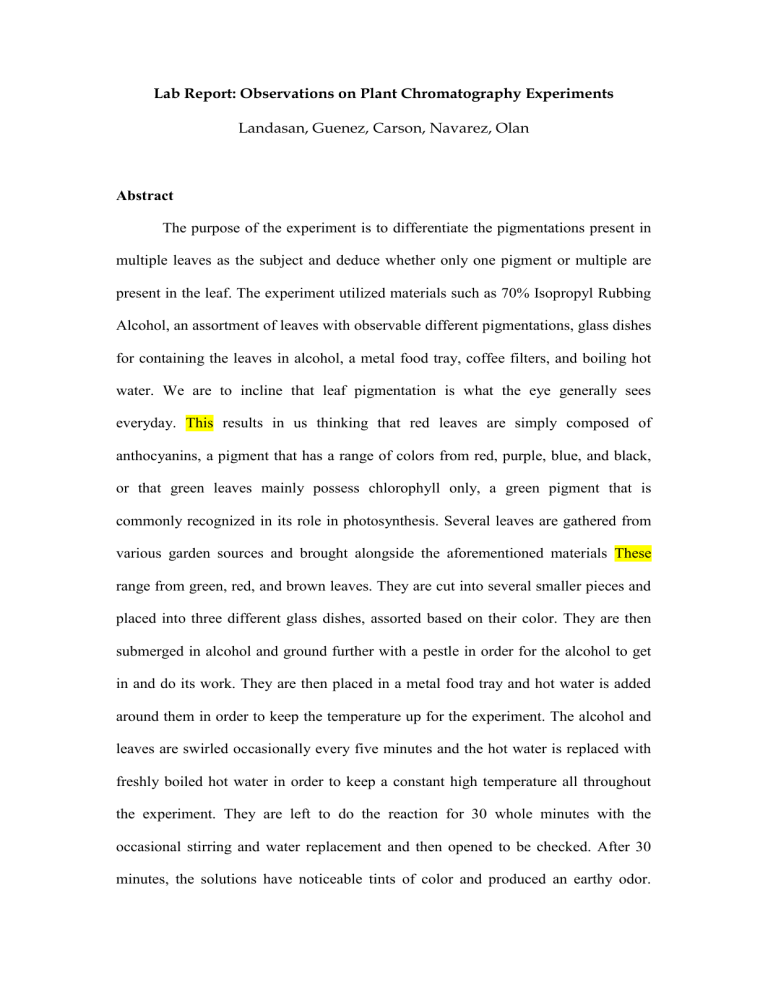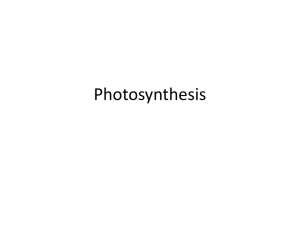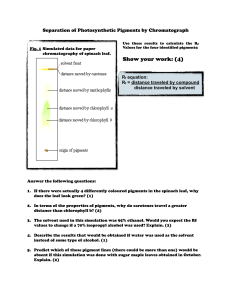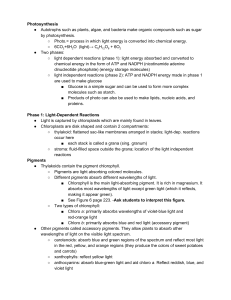
Lab Report: Observations on Plant Chromatography Experiments Landasan, Guenez, Carson, Navarez, Olan Abstract The purpose of the experiment is to differentiate the pigmentations present in multiple leaves as the subject and deduce whether only one pigment or multiple are present in the leaf. The experiment utilized materials such as 70% Isopropyl Rubbing Alcohol, an assortment of leaves with observable different pigmentations, glass dishes for containing the leaves in alcohol, a metal food tray, coffee filters, and boiling hot water. We are to incline that leaf pigmentation is what the eye generally sees everyday. This results in us thinking that red leaves are simply composed of anthocyanins, a pigment that has a range of colors from red, purple, blue, and black, or that green leaves mainly possess chlorophyll only, a green pigment that is commonly recognized in its role in photosynthesis. Several leaves are gathered from various garden sources and brought alongside the aforementioned materials These range from green, red, and brown leaves. They are cut into several smaller pieces and placed into three different glass dishes, assorted based on their color. They are then submerged in alcohol and ground further with a pestle in order for the alcohol to get in and do its work. They are then placed in a metal food tray and hot water is added around them in order to keep the temperature up for the experiment. The alcohol and leaves are swirled occasionally every five minutes and the hot water is replaced with freshly boiled hot water in order to keep a constant high temperature all throughout the experiment. They are left to do the reaction for 30 whole minutes with the occasional stirring and water replacement and then opened to be checked. After 30 minutes, the solutions have noticeable tints of color and produced an earthy odor. Coffee filter strips are then prepared and put inside the solutions in order to gather the tinted liquid for better observation, and left from 30 to 120 minutes to cool and dry. From the experiment, we can conclude that the brown leaves produced the expected reddish-brown pigment as a result of tannins, however, the red and green leaves leached out a surprising amount of yellow pigment. This may be due to the presence of xanthophylls in the leaves, which were more pronounced than the pigments they were expected to release. Keywords - pigmentation, xanthophyll, tannins, chlorophyll Introduction The purpose of the experiment is to observe the different pigments present in various plants, and compare the leaching pigments to the original pigmentation in said leaves. Any colorful material generated by a plant is referred to as a plant pigment. A pigment is a chemical substance that absorbs visible light between the wavelengths of 380 nm (violet) to 760 nm (ruby-red). Plant pigments come in a variety of shapes and sizes, and they may be found in a variety of chemical compounds. Plant pigments are responsible for the color of leaves, flowers, and fruits, as well as governing photosynthesis, growth, and development. Plant pigment chromatography is a useful technique in the separation and identification of different plant pigments. Plant pigment chromatography is useful for identifying unknown compounds often used in crime scene investigations to match ink, lipstick, or colored fibers. Plant pigments have a key role in photosynthesis, plant growth, and development (Sudhakar et al., 2016). Insects, birds, and mammals are attracted to pigments as visual signals for pollination and seed dissemination. It has been found that pigments protect plants from UV and visible light damage (Tanaka et al., 2008). All fruits contain chlorophyll, which serves as the primary pigment for capturing yellow and blue light for photosynthesis, which produces energy for plant development and growth. Carotenoids and anthocyanins, unlike chlorophylls, are accessory pigments (usually with a complementary absorbance spectrum to chlorophylls) and secondary metabolites with far more diversified structures and activities in plants, as well as greater potential nutritional and health advantages in the diet (Chen, 2015). The human diet includes a variety of pigment-rich fruits. Fruit pigment content has been researched for decades, not only because of the aesthetic appeal of mature fruit colors, but also because of the diverse spectrum of compounds that are present and responsible for the distinctive green, yellow, orange, red, blue, and purple hues. Ripening is the process through which a fruit undergoes physiological and biochemical changes to achieve desired color, flavor, fragrance, sweetness, texture, and hence eating quality. The ripening process normally takes place after a fruit has reached full maturity. When a fruit achieves complete maturity, it reaches its maximum size and weight, and its growth rate slows. Depending on the species, fruit ripening can occur on the plant or after harvest (Li, 2012). It is the process of pigments which help us understand these stages of phenomena of not only fruit but all varied plant life in general. Plant leaves include three types of pigments, and their retention or creation impacts the color of leaves before they fall away, molecules, which go beyond basic chemical formulae that specify the amount of atoms of different elements that make up the molecule. The most prominent example is glucose, which is a common sugar. Glucose, which is a disaccharide, can be purchased as a sweetener. It is usually one half of typical table sugar (sucrose). Chlorophylls, carotenoids, and anthocyanins are the three types of pigments that are present during the aging of leaves. More elaborate diagrams will be presented to demonstrate the architecture of these pigments. Carotenoids are water-repelling pigments with a very long chain that are produced in the plastids of plant cells. A common carotenoid, ß-carotene, is synthesized in the chromoplasts of the ray flowers of the sunflower, resulting in vivid yellow-orange hues. These pigments absorb preferentially in the blue wavelengths, scattering the longer wavelengths and resulting in the yellow hue. Carotenoids are left over in the chloroplasts in fall leaves and are exposed by the loss of chlorophyll. Most common examples of them are lycopene (commonly found in tomatoes) and xanthophylls (yellow hued pigment in plants). The pigments of photosynthesis are chlorophylls a and b. They're made in the photosynthetic tissues of the leaf's chloroplasts. Because of the long phytol tail of the molecule, chlorophyll molecules are particularly water repellent. The molecule's closed ring is comparable to hemoglobin in human blood, except instead of iron, it carries a magnesium ion. Because each ring includes four nitrogen atoms, it is a huge and costly chemical to produce. Chlorophyll is generally broken down at the end of the leaf's life cycle, and the plant resorbs much of the nitrogen. Anthocyanins are water-soluble pigments generated in the cytoplasm of colored plant cells via the flavonoid pathway. The sugar molecule's connection makes them highly soluble in the vacuole's sap, which is where these molecules are store once they are launched. During the fall, they are responsible for the pink-red hue of most flower petals, most red fruits (such as apples), and practically all red foliage. Anthocyanins absorb blue-green wavelengths of light, enabling red wavelengths to be dispersed by plant tissues, making these organs visible to humans as red. Objectives of the study Upon completion of the experiment, we should: As the subject, be able to distinguish the pigmentations present in various leaves. Determine if the leaf has only one pigment or many pigments. The purpose of these experiments is to: Differentiate the pigmentations present in multiple leaves as the subject Deduce whether only one pigment or multiple are present in the leaf Materials and Methods List of Materials 70% Isopropyl Rubbing Alcohol An assortment of leaves with observable different pigmentations Glass dishes for containing the leaves in alcohol a metal food tray coffee filters boiling hot water pestle Experimental Procedure (minute 30) Leaves are assorted by color, torn into pieces and dropped into the dishes They are then submerged in alcohol and ground further with a pestle. Add more hot water to keep temperature hot. As color separates, add coffee strips. Experimental Procedure (Hour 1 and minute 30) Leave for 30-120 minutes and then dry the strips. Results and Discussion I. Result Observe color of dried coffee strips. Add hot water to the metal food tray to keep temperature up Leave for 30 minutes to warm up. Swirl the leaves in the jar every 5 minutes. After two hours of drying, green leaves yielded this yellow-green color. It was somewhat surprising since one would anticipate the color to be predominantly green, but there were glimpses of yellow in there as well.The yellow-green tint on the coffee filter was significantly more noticeable and crisper with Red Leaves. It was expected to create a predominantly red pigment many hours after the experiment, therefore this was unexpected. The reddish-brown hue on the coffee filter was formed by the brown leaves. The pigment's color closely mimics the brown leaves utilized in the experiment, therefore this was the least surprising result. II. Discussion Prior the experiment, it is common to assume that the color of the leaves that the naked eyes perceive is the same with the actual pigment of the plant. Thus, this experiment is conducted to clarify if this hypothesis is true and if there is a presence of one or multiple pigments in a leaf. As aforementioned above, the green leaves which were expected to yield green pigments actually showed yellowish pigments as well. Since chlorophyll gives the plant a bright green color, it blocks out some yellow hues from the xanthophyll. It's actually present in the leaf but is only showed when the dominant green color starts to disappear. But that's not the case when it comes to the red pigment of the leaf caused by anthocyanins since it is only produced before the leaves fall off from the branches. Thus, we can conclude that the leaf's seemingly one color is a mixture of more than one pigment which became more pronounced in a certain stage of the leaf's life in a particular season. But still it is important to take note of the type of leaf used in the experiment. To make more conclusive findings, other researchers might also try performing leaf pigment chromatography on the leaves of varying colors from same tree or plant, though this might sound challenging, to test if the leaves of that particular plant changes color from green to orange, yellow, red, and brown respectively. Conclusion We may deduce from the experiment that tannins created the predicted reddish-brown pigment in the brown leaves, but that the red and green leaves leached off a surprising quantity of yellow pigment. This might be owing to the presence of xanthophylls in the leaves, which were more noticeable than the pigments predicted to be released. Appendix References Latha, P., Reddy, P.V., &Sudhakar, P. (2016)Phenotyping Crop Plants for Physiological and Biochemical Traits: Plant Pigments Retrieved from: https://www.sciencedirect.com/book/9780128040737/phenotyping-crop-plants-forphysiological-and-biochemical-traits Ohmiya, Akemi,Sasaki,Nobuhiro&Tanaka,Yoshikazu(2008) Biosynthesis of Plant Pigments: Anthocyanins, Betalains and Carotenoids Retrieved from:https://onlinelibrary.wiley.com/doi/full/10.1111/j.1365-313X.2008.03447.x Chen, Chunxian (2015) Overview of Plant Pigments Retrieved from: https://www.researchgate.net/publication/283871822_Overview_of_Plant_Pigments Li Li (2012) Fruit Pigment Changes During Ripening Retrieved from: https://www.sciencedirect.com/science/article/pii/B9780081005965216569




